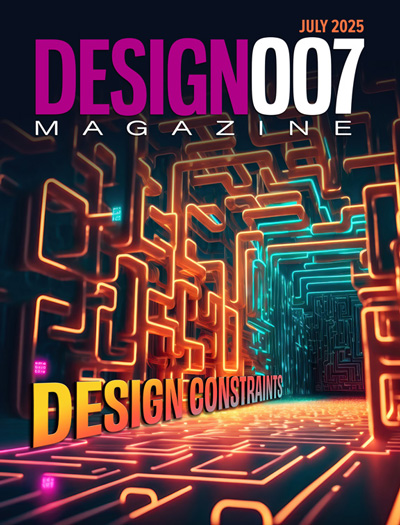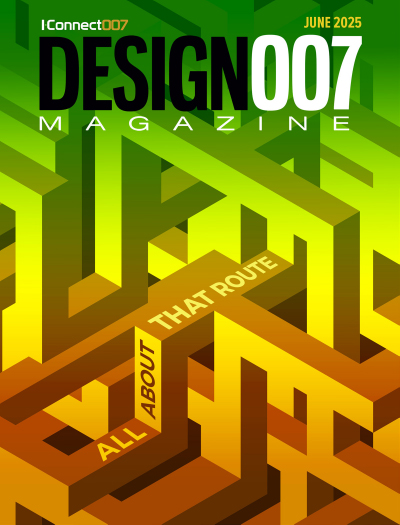-

- News
- Books
Featured Books
- design007 Magazine
Latest Issues
Current Issue
Proper Floor Planning
Floor planning decisions can make or break performance, manufacturability, and timelines. This month’s contributors weigh in with their best practices for proper floor planning and specific strategies to get it right.

Showing Some Constraint
A strong design constraint strategy carefully balances a wide range of electrical and manufacturing trade-offs. This month, we explore the key requirements, common challenges, and best practices behind building an effective constraint strategy.

All About That Route
Most designers favor manual routing, but today's interactive autorouters may be changing designers' minds by allowing users more direct control. In this issue, our expert contributors discuss a variety of manual and autorouting strategies.
- Articles
- Columns
- Links
- Media kit
||| MENU - design007 Magazine
AltiumLive 2022: Robert Feranec Takes Aim at 'Aha' Moments
February 25, 2022 | Andy Shaughnessy, Design007 MagazineEstimated reading time: 5 minutes
I recently spoke with Robert Feranec, the founder and CEO of the FEDEVEL Academy. He’s a well-known hardware engineer and something of an industry “rock star” on YouTube; his channel provides tips and techniques on digital design and engineering, with some videos clocking 400,000 views.
I asked Robert to discuss his AltiumLive 2022 presentation, “Aha, That’s How it Works.” As he explains, much of an engineer’s life involves making these little “Aha!” discoveries that challenge the way they look at electronics. In this interview, Robert shares some of the points that he makes in his presentation, which is available on the Altium website.
Andy Shaughnessy: Robert, you’ve spoken at this AltiumLive in the past, and I’m glad to see you coming back. Is this your third time speaking?
Robert Feranec: Yes, that’s correct.
Shaughnessy: Tell us about your breakout session called, “Aha, That’s How it Works.” That sounds interesting. Give us some of the highlights.
Feranec: To start, it’s always the most complicated to come up with something new and interesting. For students I wanted to create a presentation. But then I thought maybe this could be super useful even for this conference. Because I know when I ask this question on my LinkedIn, when I ask about these aha moments, I find out even engineers working for five or 10 or even more years, they still can have these moments like, “Oh, this is how it works.”
So, I thought, why to wait 10 or 15 years to discover something when we can just share them and maybe attendees might learn them after one year of working in hardware design? That’s how this idea come up, and that’s the main reason why I would like to talk about this, the moments when engineers realize that something is not really working the way as they imagine.
Shaughnessy: Are you going to give them some examples, some horror stories maybe where things go wrong or what?
Feranec: I have a number of points to talk about. The two biggest are that first, the current doesn’t always flow the shortest way. Because that’s what we are often taught when we learn physics in schools, for example. Even when they finish university, some engineers still think currents flow the shortest way, but that’s not how we should imagine currents for high-speed designs.
And the second, which is quite a big point in this presentation, is about impedance. Again, that’s something that we also learn in universities, but just theoretically. So, we know how to calculate it, we know it exists, but very often they don’t really teach how to connect this theoretical impedance with real circuits. And when you find out what it actually means in real circuits, then the reaction is, “Oh, that’s why it is important. What is the real impedance I have found?” Those are two biggest topics, what I would like to talk about.
Shaughnessy: There’s a lot of tribal knowledge, where people just keep doing the same thing because that’s how they learned it. You’ll be fighting against some of that, I suppose?
Feranec: Some of the things what I will try to show even I don’t fully understand. Even in physics, physicists will sometimes say, “Oh, I can imagine it, but I don’t fully understand exactly how it works.” Some of the topics are super complicated, but I try to imagine them the way that it makes it easy for me to understand some of the things. I’m not saying it is the perfect way and everything is going to work the way as I imagined.
Shaughnessy: So, it’s just a new way to look at an old problem.
Feranec: Exactly.
Shaughnessy: I like how you call them “aha” moments.
Feranec: Yes. For example, I remember when I started with hardware design, I was always using only resistance. I measured the resistance with my digital voltmeter, or DVM. But I always felt that if I measured very high resistance, then it’s not connecting. When I measured zero ohm, I was like, “Oh, there is a short circuit.” But once you start thinking about impedance, that’s not really true. Different frequencies will see this differently. And suddenly you realize, “Oh, yeah. If my DVM measured zero, but it’s not always zero. For some frequencies it can be one ohm, for example.” These are the “aha” moments. There are some other "aha" moments which I have on the list.
Shaughnessy: I’d love to hear them.
Feranec: Once I knew what kind of presentation I was going to make, I posted about this on my LinkedIn page. I asked other engineers to tell me about their “aha” moments. And many of them mentioned that the biggest “aha” moment was when they found out that they should not think about voltages and currents, but about energy and fields. So that’s one of the topics I would like to mention.
Then, this was interesting one for me: capacitors can sometimes be inductors. I have a couple of notes about inductance of vias, and about two-layer boards. I designed two-layer boards in the past, and after a couple of years I realized I was so naive when I thought this two-layer board was going to work.
Shaughnessy: So many people learned circuit theory; they only focus on the circuit and the traces and the copper. They don’t think about the field surrounding.
Feranec: Exactly. So basically, in my presentation I want to point out these areas. I’m not going to be super specific. It’s more like encouraging my audience to have a closer look at this topic and maybe find other presentation where they could learn a little bit more because it can be important to understand how it actually works.
Shaughnessy: Very cool. What would you say are the major takeaways?
Feranec: So, for some people, they probably will know about some of the points. But I still believe there will be people who will find some of these points to be completely new, and it will help them to think about the topics and how they might work differently than they currently think. And I really hope it will then help them to design better boards. Because once they understand little bit better how it actually works, then they can have a deeper understanding why we are doing some things in PCB layout.
Shaughnessy: Well, it sounds like a fun presentation. Thanks for speaking with me, Robert.
Feranec: Thank you, Andy.
View Robert Feranec's presentation "Ah, that's how it works!" below.
Testimonial
"In a year when every marketing dollar mattered, I chose to keep I-Connect007 in our 2025 plan. Their commitment to high-quality, insightful content aligns with Koh Young’s values and helps readers navigate a changing industry. "
Brent Fischthal - Koh YoungSuggested Items
Trouble in Your Tank: Minimizing Small-via Defects for High-reliability PCBs
08/27/2025 | Michael Carano -- Column: Trouble in Your TankTo quote the comedian Stephen Wright, “If at first you don’t succeed, then skydiving is not for you.” That can be the battle cry when you find that only small-diameter vias are exhibiting voids. Why are small holes more prone to voids than larger vias when processed through electroless copper? There are several reasons.
The Government Circuit: Navigating New Trade Headwinds and New Partnerships
08/25/2025 | Chris Mitchell -- Column: The Government CircuitAs global trade winds continue to howl, the electronics manufacturing industry finds itself at a critical juncture. After months of warnings, the U.S. Government has implemented a broad array of tariff increases, with fresh duties hitting copper-based products, semiconductors, and imports from many nations. On the positive side, tentative trade agreements with Europe, China, Japan, and other nations are providing at least some clarity and counterbalance.
How Good Design Enables Sustainable PCBs
08/21/2025 | Gerry Partida, Summit InterconnectSustainability has become a key focus for PCB companies seeking to reduce waste, conserve energy, and optimize resources. While many discussions on sustainability center around materials or energy-efficient processes, PCB design is an often overlooked factor that lies at the heart of manufacturing. Good design practices, especially those based on established IPC standards, play a central role in enabling sustainable PCB production. By ensuring designs are manufacturable and reliable, engineers can significantly reduce the environmental impact of their products.
50% Copper Tariffs, 100% Chip Uncertainty, and a Truce
08/19/2025 | Andy Shaughnessy, I-Connect007If you’re like me, tariffs were not on your radar screen until a few months ago, but now political rhetoric has turned to presidential action. Tariffs are front-page news with major developments coming directly from the Oval Office. These are not typical times. President Donald Trump campaigned on tariff reform, and he’s now busy revamping America’s tariff policy.
Global PCB Connections: Understanding the General Fabrication Process—A Designer’s Hidden Advantage
08/14/2025 | Markus Voeltz -- Column: Global PCB ConnectionsDesigners don’t need to become fabricators, but understanding the basics of PCB fabrication can save you time, money, and frustration. The more you understand what’s happening on the shop floor, the better you’ll be able to prevent downstream issues. As you move into more advanced designs like HDI, flex circuits, stacked vias, and embedded components, this foundational knowledge becomes even more critical. Remember: the fabricator is your partner.


